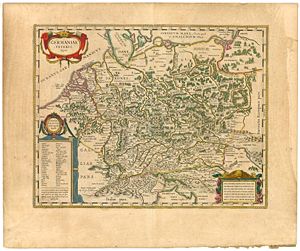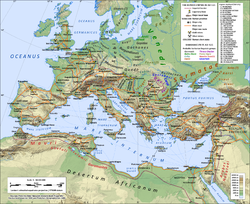- Aesti
-
History of Estonia 
This article is part of a seriesAncient Estonia Kunda culture Narva culture Aesti Chudes Baltic Finns Viking and Middle ages Oeselians Livonian Crusade Danish Estonia Old Livonia Swedish Estonia Livonian War Polish Estonia Great Northern War Modern Estonia National awakening German occupation Declaration of Independence War of Independence Era of Silence World War II Soviet occupation Republic of Estonia Chronology
Estonia Portal
 Germaniae veteris typus (historic map of the Old Germany), Aestui and Venedi on the right upper corner of the map (edited by Willem and Joan Blaeu, 1645).
Germaniae veteris typus (historic map of the Old Germany), Aestui and Venedi on the right upper corner of the map (edited by Willem and Joan Blaeu, 1645).
The Aesti (or Aestii) were a people described by the Roman historian Tacitus in his treatise Germania (ca. 98 CE).[1] According to this account, the Aestii lived on the shore of the Suebian Sea (Baltic Sea), eastward of the Suiones (Scandinavians) and westward of the Sitones. They were a population of Suebia. Tacitus did not know whether to assign the nearby Fenni to Germania or Sarmatia (which extended as far west as the Vistula in places).
Contents
Historical sources
Tacitus
.
The ancient writers, beginning with Tacitus, who was the first Roman author to mention them in his Germania, provide very little information on the Aestii.[2] Although Tacitus never travelled to Magna Germania himself and only recorded information he had obtained from others, the short ethnographic excursus below is the most detailed ancient account of the Aestii that we have:
"Upon the right of the Suebian Sea the Aestian nations reside, who use the same customs and attire with the Suebians; their language more resembles that of Britain. They worship the Mother of the Gods. As the characteristic of their national superstition, they wear the images of wild boars. This alone serves them for arms, this is the safeguard of all, and by this every worshipper of the Goddess is secured even amidst his foes. Rare amongst them is the use of weapons of iron, but frequent that of clubs. In producing of grain and the other fruits of the earth, they labour with more assiduity and patience than is suitable to the usual laziness of Germans. Nay, they even search the deep, and of all the rest are the only people who gather amber. They call it glesum, and find it amongst the shallows and upon the very shore. But, according to the ordinary incuriosity and ignorance of Barbarians, they have neither learnt, nor do they inquire, what is its nature, or from what cause it is produced. In truth it lay long neglected amongst the other gross discharges of the sea; till from our luxury, it gained a name and value. To themselves it is of no use: they gather it rough, they expose it in pieces coarse and unpolished, and for it receive a price with wonder." Germania, chapter XLV.
Apart from describing their idiom as closer to the British language than — as must be inferred — to the language of the Suebi, Tacitus mentions their term for amber in an apparently Latinised form, glesum (cf. Latvian glīsas). This is the only word of their language recorded from antiquity, but seems to be Germanic in origin (from Gothic glas).[3] In spite of these points, the Aestii are generally considered the ancestors of the later Baltic peoples.
The placement of the Tacitean Aestii is based primarily on their association with amber, a popular luxury item during the life of Tacitus, with known sources at the southeastern coast of the Baltic Sea. The Baltic amber trade, which appears to have extended to the Mediterranean Sea, has been traced by archaeologists back to the Nordic Bronze Age; its major center was located in the region of Sambia.
This trade probably existed prior to the historical Trojan War in the 13th century BCE, as amber is one of the substances in which the palace of Menelaus at Sparta was said to be rich in Homer's The Iliad.[4]
Cassiodorus
Cassiodorus' Variae, published in 537, contains a letter written by Cassiodorus in the name of Theodoric the Great, addressed to the Aesti:
"It is gratifying to us to know that you have heard of our fame, and have sent ambassadors who have passed through so many strange nations to seek our friendship.
We have received the amber which you have sent us. You say that you gather this lightest of all substances from the shores of ocean, but now it comes thither you know not. But as an author named Cornelius (Tacitus) informs us, it is gathered in the innermost islands of the ocean, being formed originally of the juice of a tree (whence its name succinum), and gradually hardened by the heat of the sun. Thus us becomes an exuded metal, a transparent softness, sometimes blushing with the color of saffron, sometimes glowing with flame-like clearness. Then, gliding down to the margin of sea, and further purified by the rolling of the tides, it is a length transported to your shores to be cast upon them. We have thought it better to point this out to you, lest you should imagine that your supposed secrets have escaped our knowledge. We sent you some presents by our ambassadors, and shall be glad to receive further visits from you by the road which you have thus opened up, and to show you future favors."The style of the letter proves that the nation was at thet time independent, not ruled by the Ostrogoths. Apparently Cassiodorus considered it politically essential to establish friendly relations with the Nordic region. The letter also indicates that the Aesti were fully confident of the value of amber and had made out of it a trade secret. The sending of presents and the promise to show future favors were in ancient times a cordial way of giving de jure recognition to another power.[5]
Jordanes
Sixth Century historian Jordanes makes two references the Aesti in his book "The Origins and the Deeds of the Goths", which was a treatment of Cassiodorus' longer book (which no longer survives) on the history of the Goths. The first quote places the Aestii beyond the Vidivarii, on the shore of the Baltic:
- "But on the shore of Ocean, where the floods of the river Vistula empty from three mouths, the Vidivarii dwell, a people gathered out of various tribes. Beyond them the Aesti, a subject race, likewise hold the shore of Ocean."
The next quote concerns the subjugation of the Aesti by Hermanaric, king of the Gothic Greuthungi:
- "This ruler also subdued by his wisdom and might the race of the Aesti, who dwell on the farthest shore of the German Ocean"
Alfred the Great
In a 11th century manuscript of King Alfred's account of the voyage from Hedeby to Truso by Wulfstan, held by the British Museum, includes ethnographic information on the medieval Aestii,[6][7] in the which the terms Esti,Est-mere and Eastland are used. In the text, a summary description of the country and its riches is followed by a very detailed account of the people's funeral customs.[1]
Adam of Bremen
During the 11th Century Adam of Bremen, citing Einhard (who in the Vita Caroli Magni states the "the Slavs and the Aisti live on the shores of the Eastern Sea"), denotes the coastal tribe as the Haisti and refers to today's Estonia as Aestland.[8]
Transference of the name
It is speculated that name survived as specifically Estonians and is the origin of the modern national name of Estonia: Eesti in Estonian, Eistland in ancient Scandinavian sagas, and Estia, Hestia and Estonia in early Latin sources.
Due to Alfred's chorography referring to the same Germanic tribe as Tacitus, every variant of the anglicised east-, Osti and the continental Esti - equates to aestius, meaning eastern or east, that is to the right side of the sea as understood from the perspective of the Germanic sailors who roamed the sea beyond the Vistula estuary. The germanic tribe referred to as the Aestii by others, who Endzelins states knew themselves as Prussians, transferred the name to the more eastern Estonians with which they had contact since the first century BC, as the Estonians did not have their own name other than maarahvas "people of the earth".[8] The Estonians themselves only took on the name in the late nineteenth century.
The American historian James L. Cabot has gone so far as to claim descent from the Aesti, partly on the basis of his family's origin in East Prussia, and partly the fact that his surname is part of a European pattern of names denoting "Coaster" ('One who trades along the coast')—e.g., English Cabot, East Prussian Kabat, Italian Caboto, and Crimean Kbat.[9]
Notes
- ^ Tacitus, Germania, Germania.XLV
- ^ For a theory that the Aestii are the Osismii of Strabo and the Ostimii of Pytheas also mentioned by Strabo, see Bojtàr, Endre (1999). Foreword to the Past: a Cultural History of the Baltic People. Central European University Press. p. 104. ISBN 9639116424. This is not a majority view as there is evidence of the continuity of the Osismii in France.
- ^ Rübekeil, Ludwig. Suebica - Völkernamen und Ethnos Innsbruck, 1992. p. 72f.
- ^ Lillian Feder (1964), Crowell's Handbook of Classical Literature, p. 192. USA: Crowell.
- ^ Edgar V. Saks. Aestii. p. 52–53.
- ^ Kemp Malone, On King Alfred's Geographical Treatise, Speculum, Vol. 8, No. 1. (Jan., 1933), pp. 67-78
- ^ Samuel H. Cross, Notes on King Alfred's North: Osti, Este, Speculum, Vol. 6, No. 2. (Apr., 1931), pp. 296-299
- ^ a b Endre Bojtár, Foreword to the past: a cultural history of the Baltic people, Central European University Press, 1999, p106
- ^ Samuel Eliot Morison (1971), The European Discovery of America. The Northern Voyages, p. 158. USA: Oxford.
See also
References
- Deutschler, Yorck: "Die Aestii - Bezeichnung für die heutigen Esten Estlands oder die untergegangenen Pruzzen Ostpreußens" , in: Deutschler, Yorck, "Die Singende Revolution" - Chronik der Estnischen Freiheitsbewegung (1987-1991), pp. 196–198. Ingelheim, March 1998/June 2000. ISBN 3-88758-077-X
- Saks, Edgar Valter (1960). Aestii, An Analysis of an Ancient European Civilization. Studies in the Ur-European History". Part 1. Montreal–Heidelberg: Võitleja. link
Categories:- Ancient peoples
- Historical ethnic groups of Europe
- Iron Age Europe
- Baltic peoples
Wikimedia Foundation. 2010.


